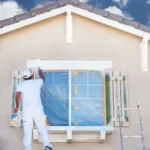When homeowners think about roof maintenance, they often focus on shingles, gutters, and potential leaks. However, one element that gets ignored is roof ventilation.
Proper roof ventilation is not just a luxury—it’s a necessity that directly impacts your roof’s lifespan, the attic’s health, and even the air quality throughout your home.
Here’s why roof ventilation matters more than you might think and how neglecting it can lead to significant problems down the road. GRB Roofing in Annapolis, MD offers expert roofing services, including ventilation assessments and solutions to help ensure your roof performs at its best year-round. If you’re looking for reliable roofing services in Annapolis, MD, check out: https://grbroofing.com/annapolis-md-roofing/
What Is Roof Ventilation?
Roof ventilation is the intake and exhaust vents system designed to circulate air in and out of your attic. The goal is to balance the temperature and moisture levels within the attic space, regardless of the season. A well-ventilated roof includes a combination of vents such as ridge vents, soffit vents, gable vents, and sometimes powered attic fans. A reliable roofing contractor can help identify ventilation problems and provide professional solutions tailored to your roof’s needs, Check out: https://lastcallexteriors.com/roof-repair-maintenance/ for more information.
How Poor Ventilation Affects Roof Lifespan
One of the most damaging effects of poor ventilation is its impact on your roof’s lifespan. Hot air is stuck in the attic during the summer without adequate airflow. This heat can cause roofing materials, particularly asphalt shingles, to age prematurely. Shingles may curl, blister, or crack, which makes them more susceptible to water infiltration and damage during storms.
Additionally, trapped heat in the attic can cause uneven roof temperatures in colder months, leading to ice dam formation. Ice dams do not let melting snow drain off the roof properly, forcing water under the shingles and into your home, causing water damage and decay to your roof decking.
Proper ventilation helps preserve the integrity of roofing materials and ensures their long-term performance. It maintains consistent temperatures and reduces excessive heat buildup.
ALSO READ: How to Start a Blog from Scratch: A Beginner’s Guide
The Moisture Problem: Mold and Rot in the Attic
Another critical reason roof ventilation is so important is moisture control. Everyday activities like cooking, showering, and laundry generate moisture that rises into the attic. Without a proper escape route through exhaust vents, this moisture becomes trapped and condenses on attic surfaces.
Over time, this moisture can cause serious issues such as:
- Mold and mildew growth: These can spread quickly, creating health risks to your family and damaging stored items.
- Wood rot: Prolonged moisture exposure weakens structural elements of the roof, including the rafters and decking.
- Insulation degradation: Wet insulation loses its effectiveness, reducing your home’s energy efficiency and increasing utility bills.
Proper ventilation allows moisture-laden air to escape the attic, keeping the space dry and reducing the risk of mold, rot, and energy inefficiency.
Indoor Air Quality and Home Comfort
While the attic may seem far removed from your living space, poor ventilation can surprisingly affect the air quality inside your home. When hot, stale, or moist air accumulates in the attic, it can seep down into your living areas. This can lead to increased humidity levels indoors, which may cause discomfort and promote the growth of allergens like mold spores and dust mites.
Furthermore, a poorly ventilated attic often results in uneven home temperatures, especially on the upper floors. This can force your HVAC system to work harder to maintain comfort, increasing wear and tear on the system and elevating your energy costs.
With a properly ventilated attic, your HVAC system can run more efficiently, and your indoor air will be fresher and healthier to breathe.
Signs Your Roof May Have Poor Ventilation
Not sure if your roof ventilation is up to par? Here are some warning signs to look out for:
- Hot or stuffy attic: Ventilation could be an issue if your attic feels significantly hotter than the outside temperature.
- Mold or mildew odor: A musty smell often indicates moisture buildup.
- Rust on metal fixtures: Condensation can cause nails, pipes, and other metal components in your attic to rust.
- Ice dams in winter: As mentioned earlier, these are a clear sign of temperature imbalances caused by poor ventilation.
- High energy bills: Poor airflow can strain your HVAC system, especially in extreme temperatures.
How to Improve Roof Ventilation
The best way to improve roof ventilation is to create a stable system of intake and exhaust. Soffit vents allow cool air to enter the attic, while ridge or gable vents let hot air escape. In some cases, homeowners may benefit from installing attic fans or turbine vents to enhance air circulation.
It’s also crucial to ensure insulation doesn’t block airflow at the eaves, as this can disrupt the whole system. A professional roofing contractor can inspect your setup and recommend the best solutions for your home’s layout and climate.
ALSO READ: Laying Herringbone tiles
Conclusion: A Smart Investment for Every Home
Roof ventilation may not be the most visible part of your home, but it plays a vital role in protecting your roof, your attic, and the air you breathe. By investing in proper ventilation, you can extend the life of your roof, prevent costly moisture damage, reduce energy bills, and improve your home’s overall comfort and safety.
If you’re unsure about the state of your roof ventilation, now is the perfect time to get it checked. A simple inspection and a few upgrades could save you thousands in the long run—and give you peace of mind knowing your home is breathing easy.






